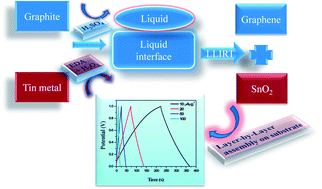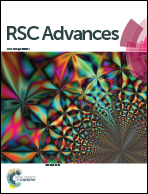Facile room temperature methods for growing ultra thin films of graphene nanosheets, nanoparticulate tin oxide and preliminary assessment of graphene–tin oxide stacked layered composite structure for supercapacitor application†
Abstract
We report a novel, facile, single step process for growing highly uniform few layer graphene nanosheet (FLGNS) thin films over a micrometer scale, formed at the liquid–air interface. The process is further extended to form monolayer graphene nanosheets (GNS). The films are characterized by Raman spectroscopy, Atomic force microscopy (AFM) and X-ray photoelectron spectroscopy (XPS). The results indicate that very few chemical and/or physical defects are introduced during formation of films. Further, an innovative single step method to form tin oxide (SnO2) films at the liquid–air interface is presented. A special feature of the method is that entire process is completed at room temperature. The film can be suitably transferred to the desired substrates by Blodgett technique. Characterization by various techniques such as XPS, TEM and energy dispersive spectroscopy (EDS) shows that the films are made up of uniform spherical, crystalline SnO2 particles with the size in the range of 3–5 nm. Layer-by-layer (LbL) techniques can be exploited to stack graphene and SnO2 films alternately, in a desired sequence, forming a stacked composite structure. The composite structure is subjected to characterization by XPS, FE-SEM, TEM and EDS. The results show that the structure consists of a stack of predetermined thickness consisting of alternate layers of both the components. Such a structure is subjected to cyclic voltammetry (CV) studies. The results suggest LbL grown SnO2–GNS stacked composites exhibit better electrochemical performance in terms of specific capacitance and cycling ability which are primary requirements for the supercapacitor application. The coating techniques of few layer graphene nanosheets, SnO2 film and their stacked composite film are simple and inexpensive. A suitable explanation of the formation of both GNS and SnO2 films is discussed. The proposed methods extend the scope for production of high quality and defect free graphene nanosheets (GNS) and other components for forming LbL stacking of composite films.


 Please wait while we load your content...
Please wait while we load your content...